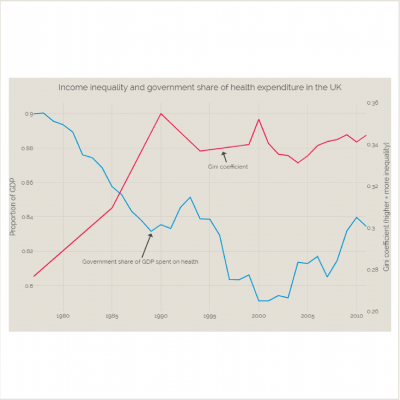Income inequality and government share of health expenditure in the UK
2 June 2015

- Generally, as income inequality grows, so does private (relative to public) health spending.
- When we see a jump in income inequality, we tend to see an increase in proportional private health spending.
- In the UK, the relatively low levels of inequality in the late ‘70s coincided with the highest proportion of government spending since 1977. Inequality rose and the government share of spending fell consistently until the early ‘90s.
As income inequality (as measured by the GINI coefficient) grows, so does our private health expenditure, relative to public expenditure.
This may make sense: as people become relatively wealthy are they more likely to want and afford private health care? But it is hard to say whether this is correlation or causation.
There are stark differences in levels of health care for high income countries. This relationship does not occur in all high income countries, but whenever we see a jump in income inequality, as in the UK in the 1980s, Italy in the early 1990s, Canada in the late 1990s, we tend to see a sharp increase in the proportional private health spend.
Source: All data are available from the OECD iLibrary: http://www.oecd-ilibrary.org/
Work with us
We look for talented and passionate individuals as everyone at the Health Foundation has an important role to play.
View current vacanciesThe Q community
Q is an initiative connecting people with improvement expertise across the UK.
Find out more

